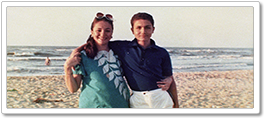Text and Photographs by Norbert Schiller
The smog and haze that hangs over Cairo for much of the summer had just started to lift in preparation for fall, but the temperatures were still soaring in the early afternoon of September 11, 2001. I headed out for a meeting with a colleague who was working on an economic survey on Syria and was interested in having me contribute some of my photographs for the report. My wife and I had recently returned from Istanbul, where we had finally celebrated our honeymoon 11 years after our wedding. We had been so enthralled with the city that we had started planning our return trip to explore other parts of the country. We were all oblivious to the fact that this fateful day would not only interrupt our immediate plans but change our lives and the world forever.
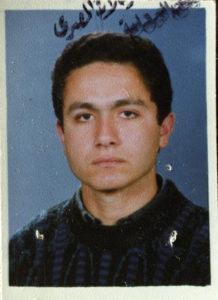
Mohamed Atta
After meeting Andrew Tabler at one of our favorite lunch spots in Cairo, I dropped him off at his apartment and went back home for what I thought would be a short break before going back out to tackle some errands. As I arrived home, I got a distraught call from Andrew asking, “who are the PFLP?” I couldn’t remember what the acronym stood for, so I replied, “they are a Palestinian liberation group much like the PLO. Why are you asking? what happened?” Andrew went on to say, “my mother just called from Pennsylvania to say that two planes flew into the World Trade Center in New York and that the PFLP was claiming responsibility for the attack!” To this day, I don’t know who reported that the Popular Front for the Liberation of Palestine, a hardline leftist PLO faction led by George Habash, had declared responsibility for the 9/11 attacks. Like so many other false claims to this spectacular attack, this one vanished as quickly it emerged. Even 20 years after 9/11, I cannot find any trace of this claim on the internet.
After parking the car, I ran up to our 3rd floor apartment at the northern tip of the island of Zamalek, turned on CNN, and stared dumbfounded as the station replayed footage of the planes crashing into the Twin Towers. When my wife Zina heard about the attacks, she rushed home from work to call friends in New York and inquire about their safety. Then our children Alexandra, 9, and Tamer, 5, were dropped off by their school bus as usual, but when they came rushing in they knew full well that something big had happened. To this day, Alexandra still remembers that as soon as they stepped in, I told them to go to their room and stay there until they were allowed back in the living room. As the afternoon waned, I stayed glued to the television waiting for an announcement of an Egyptian connection to the attacks.

Mohamed Atta’s student card at the American University in Cairo where he took an English course in 1984-85. Atta’s student card from Cairo University where he got his undergraduate degree in architecture. Phot. Atta Family Collection
I can’t recall when I first heard the name Mohamed Atta. However, Lachlan Carmichael, who was a correspondent for Agence France Presse in Cairo at the time, remembers that on September 13 the interior minister of the city state of Hamburg, Olaf Scholtz, mentioned Atta as one of the 19 hijackers involved in the attack. As soon as word got out that Atta was Egyptian, there was a frenzy among the local and foreign media based in Cairo to locate his family and secure a scoop.

Egyptians reading the newspaper headlines, the morning after 9/11, at a kiosk on Tahrir Square in the center of Cairo
My first assignment in connection with 9/11 was to cover the reaction on the street the morning after the attack. I headed to Tahrir Square, in the center of Cairo, where all the newspaper kiosks were located, to photograph people buying newspapers, reading the headlines, and staring at the pictures of the planes slamming into the Twin Towers.

The old wall surrounding medieval Islamic Cairo built by the Fatimids in the 11th century. Mohamed Atta working as a foreman at a building site in Cairo after graduating with a degree in architecture from Cairo University. Atta made references to Old Cairo in his graduate thesis about the old quarter of Aleppo. Phot. (R) Atta Family Collection
My second assignment came from the New York Times shortly after Atta’s name was made public. My task was to photograph the old stone wall surrounding Cairo. “I know it’s late, but we really need a photo to illustrate Mohammed Atta’s time at university when he studied architecture,” the editor told me. It turned out that Atta’s thesis, while studying in Germany, was on the preservation of Islamic architecture in Aleppo, Syria but he also made reference to the architecture of old Cairo. By the time I reached the 11th century Bab el Nasr (one of the old city gates) the sun had set, and, in the rush to get there, I had forgotten to bring a tripod which was essential to shoot in low light while using film. Therefore, I had to improvise by leaning my body against the side of the car and bracing my elbows on the roof to create a human tripod. After several attempts, I managed to keep the camera steady enough to get a few sharp shots.

Mohamed el-Amir Atta, the father of Mohamed Atta, speaking with correspondents from Der Spiegel Magazine nine days after the 9/11 attacks.
Next, I was commissioned to photograph Atta’s father, Mohamed el-Amir Atta during an interview with the German Der Spiegel magazine. The meeting, arranged through the Ministry of Information, was heavily monitored by Egyptian security services. When we arrived at Nadi el Said or the Shooting Club in Cairo’s posh neighborhood of Mohandessin, the patio area connected to the club’s outdoor café had been emptied of regular patrons and Atta sat at a table in the center covered with the day’s newspapers. Besides Atta, the two Der Spiegel correspondents, and myself, there were a few shady looking characters dressed in dated double breasted suits, pretending to read newspapers at other tables scattered around the patio. It was obvious that Egypt’s mukhabarat or secret police was also interested in hearing what Mohamed Atta’s father had to say. Unsurprisingly, Atta, a retired lawyer, was keen on declaring his son’s innocence. He claimed that he had spoken to the younger Atta a few days after the attack, and everything was fine with him. According to him, the CIA and the Israeli Mossad were behind the attacks.

Mohamed el-Amir Atta during an interview with Der Spiegel where he describes his son as a shy but clever young man who excelled at his studies.
Atta senior told us that his son was a serious student who excelled at school. He described him as a shy young man who only had few friends, something he had encouraged to ensure that he remained focused on his studies. Atta senior had also encouraged his two daughters to pursue higher education which is not always the case in a typical patriarchal society like Egypt. One of his daughters went on to become a medical doctor and the other a zoologist.
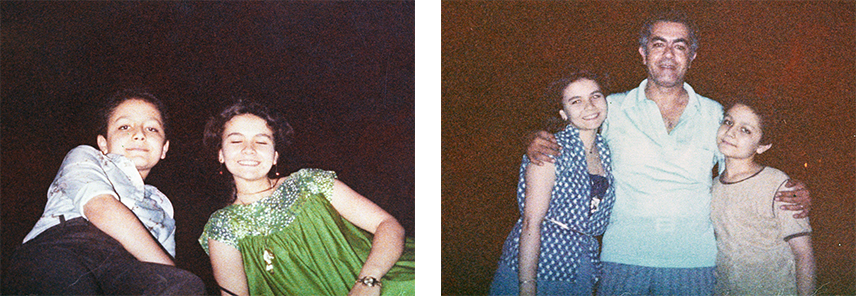
A young Mohamed Atta pictured smiling with one of his sisters. The other image shows him with his father and one of his sisters.
The days and weeks following 9/11 have all blended together, but thanks to my dated film sleeves I am able to reconstruct the events from my perspective as a journalist working in Egypt. Two weeks after the interview with Atta’s father, Der Spiegel gave me a small selection of original photographs belonging to the Atta family to copy. The half dozen intimate images show a young Mohamed Atta with his parents and two older sisters. One photo of a teenage Atta with one of his sisters suggests that they are in a romantic relationship, if one hadn’t known any better. A week later, I was privy to more Atta family photos which I was asked to copy for the New York Times’ Cairo office. This collection also included a few school identity cards including two from the American University in Cairo where Atta had taken English language classes in the mid- 1980s. In order to copy the photographs and other visuals, I used a copy stand to lay the items flat and shoot them with my film camera. Then I developed the color film and transmitted the photos using a film scanner hooked to my computer which was connected to the home phone.
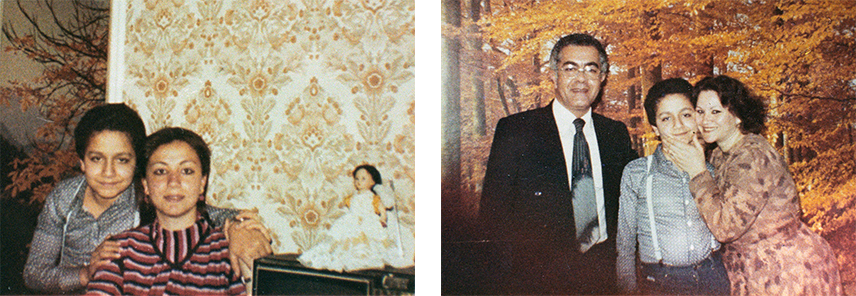
Mohamed Atta with one of his sisters. The other photo shows him standing between his parents during what seems to be a formal occasion judging by their clothes. Phot. Atta Family Collection
Both Der Spiegel and the NYT were only interested in publishing what they considered to be the top two or three images in the collection. The remaining images stayed in my archives along with the thousands of other film strips that I had taken over the years. The value of the 31 photographs and identity cards in the family album is that they give a rare glimpse into Atta’s childhood and early adult life. These visuals suggest that Atta, born in 1968, grew up in a family that was affectionate, well- educated, modern in dress and not outwardly religious. When they traveled on family vacations to Egypt’s North Coast and the Red Sea, neither Atta’s mother nor his two older sisters wore the traditional hijab or head scarf which became the norm for middle-class Moslem families in Egypt in the late 1970s and 1980s. Besides family snapshots, there are photos that show Atta with other students or colleagues at construction sites, most probably taken either between 1985 and 1990 when he was studying at Cairo University’s School of Engineering or after he graduated and began working as a foreman between 1990 and 1992. In all these photographs, he looks much younger than his peer which indicates that he may have skipped some grades at school due to this performance. Finally, there are a few photos of Atta in his late teens at the Red Sea resort of Sharm el Sheikh with his family and at a diving club with friends.
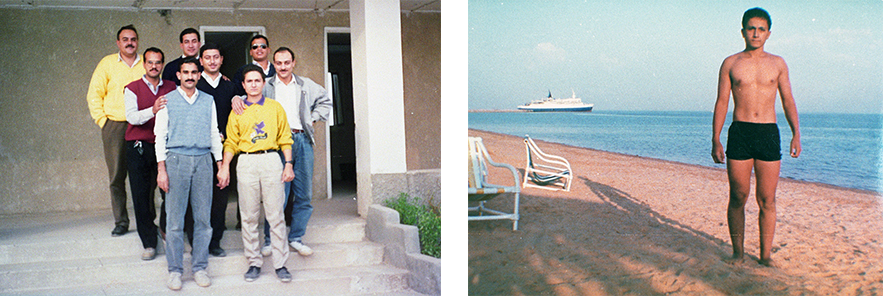
Mohamed Atta with colleagues from work. Atta in a bathing suit at the Red Sea resort of Sharm el Sheikh. Phot. Atta Family Collection
After graduating from Cairo University in 1990, Atta began working as a foreman at a construction site and joined the Engineers’ Syndicate. Like most professional unions in Egypt, the Engineers’ Syndicate was known to be heavily influenced by the Moslem Brotherhood, which had a long history of being at odds with Egypt’s ruling elite, opposing the peace deal with Israel and shunning Egypt’s pro-western politics. Whether Atta was influenced by the Brotherhood to adopt a stricter form of Islam is anyone’s guess, but his focus at the time seemed to be his career and professional development. Besides taking English classes at the American University in Cairo, Atta learned German at the Goethe Institute which would prepare him for the next chapter of his life, studying architecture at the Hamburg University of Technology.
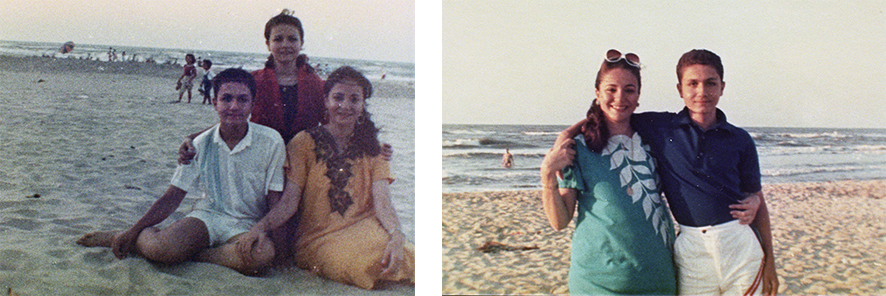
Mohammed with his two sisters on vacation at the Red Sea resort of Sharm el Sheikh. Photo on the right shows him with one of the two sisters. Phot. Atta Family Collection
Based on the news accounts that attempted to reconstruct the reasons behind the attacks and the motives of the perpetrators, Atta had been converted to extremism during his seven-year stint in Germany between 1992 and 1999. When I was asked to photograph the old wall of Cairo, two days after 9/11, I had no idea that his research on the preservation of the old quarter of Aleppo in Syria, was more than just an academic paper. I recently learned that Atta’s thesis was a platform for him to vent his anger against the West and Arab regimes like Syria and Egypt which were fixated on modernizing their countries at the expense of their heritage. Atta was vehemently opposed to the Egyptian authorities’ demolition of traditional homes in Old Cairo to make the area more appealing to tourists. He couldn’t understand how foreign tourist were more important than the people who lived in these historic neighborhoods. He saw western style high-rise buildings as alien and an insult to traditional Islamic architecture which gave an identity to the old quarters in Cairo, where he grew up, and to Aleppo where he worked on his thesis.

